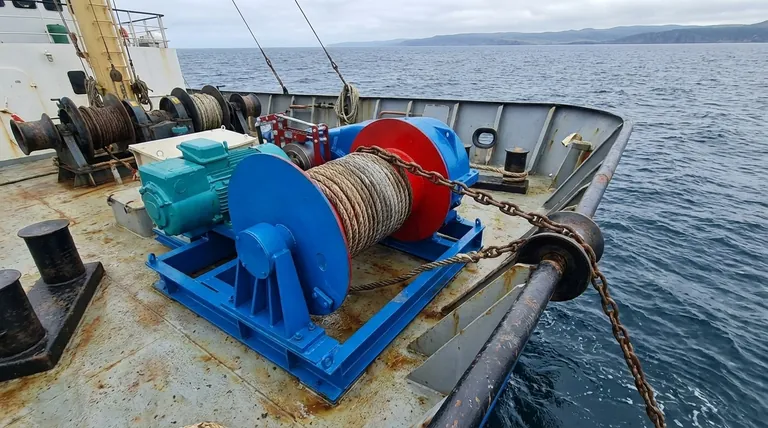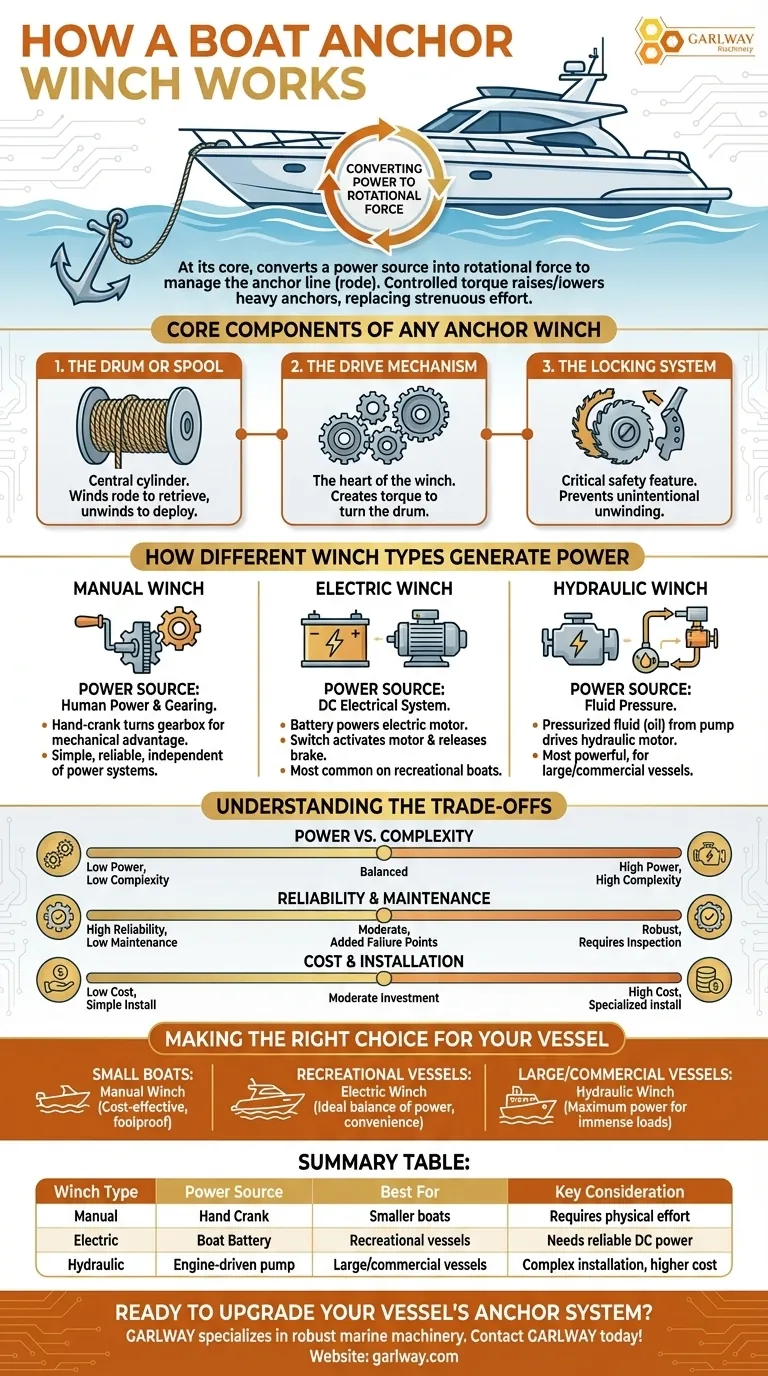At its core, a boat anchor winch works by converting a power source into rotational force to manage the anchor line, known as the rode. An electric or hydraulic motor (or a manual hand crank) turns a central drum. This drum winds the rope and chain to retrieve the anchor or unwinds it to deploy it, all controlled by a simple switch or lever.
A winch is fundamentally a system of mechanical advantage. It transforms energy—be it manual, electric, or hydraulic—into the controlled torque needed to raise or lower a heavy anchor, replacing strenuous physical effort with a managed, safer process.

The Core Components of Any Anchor Winch
Regardless of the power source, almost all anchor winches share a few fundamental components that work together to manage the anchor.
The Drum or Spool
The drum is the central cylinder onto which the anchor rode (the rope and/or chain) is wound. Its rotation, controlled by the drive mechanism, directly pulls the anchor in or lets it out.
The Drive Mechanism
This is the heart of the winch. It is the system that creates the rotational force, or torque, needed to turn the drum against the weight of the anchor and the forces of wind and current.
The Locking System
A critical safety feature, the locking system prevents the drum from unintentionally unwinding. This can be a ratchet mechanism in a manual winch or a brake system in a powered winch, ensuring the anchor stays put once set or retrieved.
How Different Winch Types Generate Power
The primary difference between winch types lies in how they power the drive mechanism. This choice impacts everything from performance and complexity to cost.
Manual Winches: Human Power and Gearing
A manual winch uses a hand-crank to turn a gearbox. This series of gears provides a mechanical advantage, allowing a person to generate enough torque to lift a heavy anchor with relatively little effort. They are simple, reliable, and independent of any power system.
Electric Winches: The Motor-Driven Standard
This is the most common type on recreational boats. The process is straightforward:
- Power flows from the boat's DC electrical system (usually a battery) to an electric motor.
- Pressing a switch activates the motor, which simultaneously releases a brake.
- The electric motor generates torque, rotating the drum to wind or unwind the rode.
Hydraulic Winches: The Power of Fluid Pressure
Hydraulic winches are the most powerful and are typically found on larger commercial vessels. They operate using pressurized fluid, usually oil. A pump, often driven by the engine, pressurizes the fluid and sends it to a hydraulic motor, which then turns the winch drum with immense force.
Understanding the Trade-offs
Choosing a winch isn't just about power; it's about balancing performance, complexity, and reliability for your specific needs.
Power vs. Complexity
Hydraulic winches offer unmatched pulling power but require a complex system of pumps, hoses, and fluid reservoirs. Electric winches provide excellent power for most situations with a simpler installation. Manual winches are the least complex but are limited by the operator's physical strength.
Reliability and Maintenance
Fewer moving parts make manual winches extremely reliable and easy to maintain. Electric systems add potential failure points like wiring, switches, and the motor itself. Hydraulic systems are robust but introduce the risk of fluid leaks and require regular inspection of hoses and seals.
Cost and Installation
Installation complexity directly correlates with cost. Manual winches are the most affordable and simplest to install. Electric winches represent a moderate investment in both equipment and installation labor. Hydraulic winches are the most expensive option, requiring specialized knowledge for a safe and effective installation.
Making the Right Choice for Your Vessel
Your choice should be dictated by your vessel's size, your power systems, and your operational needs.
- If your primary focus is simplicity and reliability on a smaller boat: A manual winch offers a cost-effective and virtually foolproof solution.
- If your primary focus is convenience for a recreational vessel: An electric winch provides the ideal balance of power, ease of use, and manageable installation.
- If your primary focus is maximum power for a large or commercial vessel: A hydraulic winch is the only option that can safely handle the immense loads required.
Understanding these core principles empowers you to operate your anchor system safely and select the right technology for your needs.
Summary Table:
| Winch Type | Power Source | Best For | Key Consideration |
|---|---|---|---|
| Manual | Hand Crank | Smaller boats, simplicity, reliability | Requires physical effort |
| Electric | Boat Battery | Recreational vessels, convenience | Needs a reliable DC power system |
| Hydraulic | Engine-driven pump | Large/commercial vessels, maximum power | Complex installation, higher cost |
Ready to upgrade your vessel's anchor system?
GARLWAY specializes in robust construction and marine machinery, offering reliable winches designed for demanding environments. Whether you're a commercial operator or a serious boater, our solutions provide the power and durability you need for safe and efficient anchor handling.
Contact GARLWAY today to discuss the perfect winch for your vessel!
Visual Guide

Related Products
- Electric Hoist Winch Boat Anchor Windlass for Marine Applications
- Heavy Duty Electric Boat Winch Windlass Anchor
- Warn Winch Windlass Boat Trailer Winch
- Best 18000 Pound Drum Anchor Trailer Winch
- Ready Mixer Machine for Construction Ready Mix Machinery
People Also Ask
- What are the benefits of consistent lifting power in electric hoists? Boost Productivity & Safety
- How should the hoist winch be debugged after installation? A 3-Phase Guide to Ensure Safety & Reliability
- How do electric hoists help prevent workplace injuries? Engineer a Safer, More Efficient Workspace
- What are the advantages of an electrically operated trailer winch? Enhance Safety & Control for Your Trailer
- What are the pros and cons of electrical winches? Make the Right Choice for Your Project


















